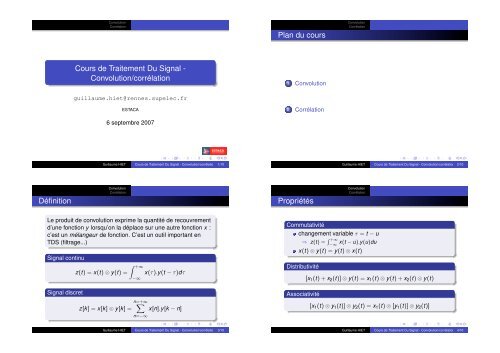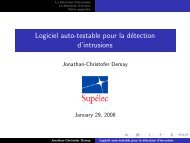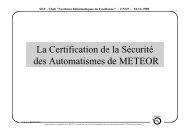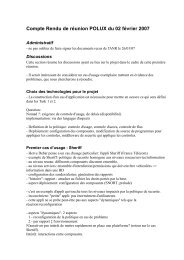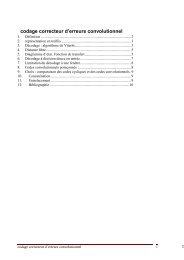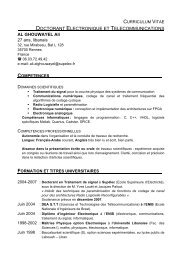Cours de Traitement Du Signal - Convolution/corrélation
Cours de Traitement Du Signal - Convolution/corrélation
Cours de Traitement Du Signal - Convolution/corrélation
You also want an ePaper? Increase the reach of your titles
YUMPU automatically turns print PDFs into web optimized ePapers that Google loves.
<strong>Convolution</strong><br />
Corrélation<br />
Plan du cours<br />
<strong>Convolution</strong><br />
Corrélation<br />
<strong>Cours</strong> <strong>de</strong> <strong>Traitement</strong> <strong>Du</strong> <strong>Signal</strong> -<br />
<strong>Convolution</strong>/corrélation<br />
1 <strong>Convolution</strong><br />
guillaume.hiet@rennes.supelec.fr<br />
ESTACA<br />
2 Corrélation<br />
6 septembre 2007<br />
Guillaume HIET <strong>Cours</strong> <strong>de</strong> <strong>Traitement</strong> <strong>Du</strong> <strong>Signal</strong> - <strong>Convolution</strong>/corrélation 1/10<br />
Guillaume HIET <strong>Cours</strong> <strong>de</strong> <strong>Traitement</strong> <strong>Du</strong> <strong>Signal</strong> - <strong>Convolution</strong>/corrélation 2/10<br />
Définition<br />
<strong>Convolution</strong><br />
Corrélation<br />
Propriétés<br />
<strong>Convolution</strong><br />
Corrélation<br />
Le produit <strong>de</strong> convolution exprime la quantité <strong>de</strong> recouvrement<br />
d’une fonction y lorsqu’on la déplace sur une autre fonction x :<br />
c’est un mélangeur <strong>de</strong> fonction. C’est un outil important en<br />
TDS (filtrage...)<br />
<strong>Signal</strong> continu<br />
<strong>Signal</strong> discret<br />
z(t) = x(t) ⊗ y(t) =<br />
z[k] = x[k] ⊗ y[k] =<br />
∫ +∞<br />
−∞<br />
n=+∞<br />
∑<br />
n=−∞<br />
x(τ).y(t − τ)dτ<br />
x[n].y[k − n]<br />
Commutativité<br />
changement variable τ = t − u<br />
⇒ z(t) = ∫ +∞<br />
x(t − u).y(u)du<br />
−∞<br />
x(t) ⊗ y(t) = y(t) ⊗ x(t)<br />
Distributivité<br />
Associativité<br />
[x 1 (t) + x 2 (t)] ⊗ y(t) = x 1 (t) ⊗ y(t) + x 2 (t) ⊗ y(t)<br />
[x 1 (t) ⊗ y 1 (t)] ⊗ y 2 (t) = x 1 (t) ⊗ [y 1 (t)] ⊗ y 2 (t)]<br />
Guillaume HIET <strong>Cours</strong> <strong>de</strong> <strong>Traitement</strong> <strong>Du</strong> <strong>Signal</strong> - <strong>Convolution</strong>/corrélation 3/10<br />
Guillaume HIET <strong>Cours</strong> <strong>de</strong> <strong>Traitement</strong> <strong>Du</strong> <strong>Signal</strong> - <strong>Convolution</strong>/corrélation 4/10
Exemple<br />
<strong>Convolution</strong><br />
Corrélation<br />
Définition<br />
<strong>Convolution</strong><br />
Corrélation<br />
Mesure énergétique <strong>de</strong> la similitu<strong>de</strong> <strong>de</strong> forme et <strong>de</strong> position<br />
entre <strong>de</strong>ux signaux décalés. La définition dépend du type <strong>de</strong><br />
signal<br />
Guillaume HIET <strong>Cours</strong> <strong>de</strong> <strong>Traitement</strong> <strong>Du</strong> <strong>Signal</strong> - <strong>Convolution</strong>/corrélation 5/10<br />
Guillaume HIET <strong>Cours</strong> <strong>de</strong> <strong>Traitement</strong> <strong>Du</strong> <strong>Signal</strong> - <strong>Convolution</strong>/corrélation 6/10<br />
<strong>Convolution</strong><br />
Corrélation<br />
Signaux à énergie finie<br />
<strong>Convolution</strong><br />
Corrélation<br />
Signaux à énergie finie<br />
Autocorrélation<br />
Rxx(τ) 0 =<br />
Intercorrélation<br />
Rxy(τ) 0 =<br />
Interprétation<br />
∫ +∞<br />
−∞<br />
∫ +∞<br />
−∞<br />
x(t).x(t − τ)dt<br />
x(t).y(t − τ)dt<br />
Rxx 0 et Rxy 0 homogènes à une énergie<br />
Energie croisée entre un signal et un autre retardé<br />
Propriétés pour les signaux réels<br />
R 0 yx(τ) = R 0 xy(−τ)<br />
R 0 xx(τ) = R 0 xx(−τ) autocorrélation paire<br />
|R 0 yx(τ)| 2 R 0 xx(τ).R 0 yy(τ)<br />
R 0 xx(τ) R 0 xx(0) (E Tot )<br />
R 0 xy(τ) = 0 ⇒ signaux totalement décorrélés, signaux<br />
orthogonaux<br />
Guillaume HIET <strong>Cours</strong> <strong>de</strong> <strong>Traitement</strong> <strong>Du</strong> <strong>Signal</strong> - <strong>Convolution</strong>/corrélation 7/10<br />
Guillaume HIET <strong>Cours</strong> <strong>de</strong> <strong>Traitement</strong> <strong>Du</strong> <strong>Signal</strong> - <strong>Convolution</strong>/corrélation 8/10
<strong>Convolution</strong><br />
Corrélation<br />
Signaux à puissance moyenne totale finie<br />
<strong>Convolution</strong><br />
Corrélation<br />
Signaux à puissance moyenne totale finie<br />
Autocorrélation<br />
Intercorrélation<br />
Interprétation<br />
R ∞ xx (τ) =<br />
R ∞ xy (τ) =<br />
lim<br />
∆T →∞<br />
lim<br />
∆T →∞<br />
∫<br />
1 +<br />
∆T<br />
2<br />
x(t).x(t − τ)dt<br />
∆T − ∆T<br />
2<br />
∫<br />
1 +<br />
∆T<br />
2<br />
x(t).y(t − τ)dt<br />
∆T − ∆T<br />
2<br />
R ∞ xx et R ∞ xy homogènes à une puissance<br />
Puissance croisée entre un signal et un autre retardé<br />
Propriétés pour les signaux réels<br />
R ∞ yx (τ) = R ∞ xy (−τ)<br />
R ∞ xx (τ) = R ∞ xx (−τ) autocorrélation paire<br />
|R ∞ yx (τ)| 2 R ∞ xx (τ).R ∞ yy (τ)<br />
R ∞ xx (τ) R ∞ xx (0) (P MoyTot )<br />
R ∞ xy (τ) = 0 ⇒ signaux totalement décorrélés, signaux<br />
orthogonaux<br />
Guillaume HIET <strong>Cours</strong> <strong>de</strong> <strong>Traitement</strong> <strong>Du</strong> <strong>Signal</strong> - <strong>Convolution</strong>/corrélation 9/10<br />
Guillaume HIET <strong>Cours</strong> <strong>de</strong> <strong>Traitement</strong> <strong>Du</strong> <strong>Signal</strong> - <strong>Convolution</strong>/corrélation 10/10


